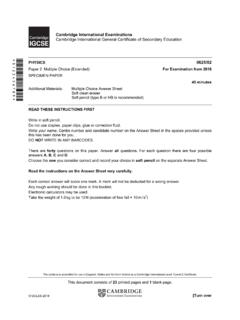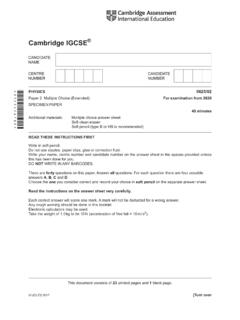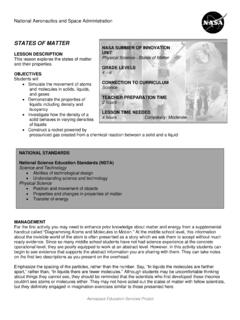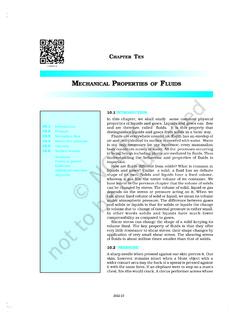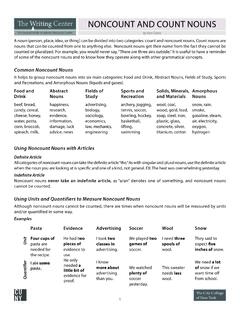Transcription of Grade Five Science Standards of Learning for Virginia Public …
1 1 Grade Five Science Standards of Learning for Virginia Public Schools January 2010 Introduction The Science Standards of Learning for Virginia Public Schools identify academic content for essential components of the Science curriculum at different Grade levels. Standards are identified for kindergarten through Grade five, for middle school, and for a core set of high school courses Earth Science , Biology, Chemistry, and Physics. Throughout a student s Science schooling from kindergarten through Grade six, content strands, or topics are included. The Standards of Learning in each strand progress in complexity as they are studied at various Grade levels in grades K-6, and are represented indirectly throughout the high school courses. These strands are Scientific Investigation, Reasoning, and Logic; Force, Motion, and Energy; Matter; Life Processes; Living Systems; Interrelationships in Earth/Space Systems; Earth Patterns, Cycles, and Change; and Earth Resources.
2 Five key components of the Science Standards that are critical to implementation and necessary for student success in achieving Science literacy are 1) Goals; 2) K-12 Safety; 3) Instructional Technology; 4) Investigate and Understand; and 5) Application. It is imperative to Science instruction that the local curriculum consider and address how these components are incorporated in the design of the kindergarten through high school Science program. Goals The purposes of scientific investigation and discovery are to satisfy humankind s quest for knowledge and understanding and to preserve and enhance the quality of the human experience. Therefore, as a result of Science instruction, students will be able to achieve the following objectives: 1. Develop and use an experimental design in scientific inquiry. 2. Use the language of Science to communicate understanding. 3. Investigate phenomena using technology. 4. Apply scientific concepts, skills, and processes to everyday experiences.
3 2 5. Experience the richness and excitement of scientific discovery of the natural world through the collaborative quest for knowledge and understanding. 6. Make informed decisions regarding contemporary issues, taking into account the following: Public policy and legislation; economic costs/benefits; validation from scientific data and the use of scientific reasoning and logic; respect for living things; personal responsibility; and history of scientific discovery. 7. Develop scientific dispositions and habits of mind including: curiosity; demand for verification; respect for logic and rational thinking; consideration of premises and consequences; respect for historical contributions; attention to accuracy and precision; and patience and persistence. 8. Develop an understanding of the interrelationship of Science with technology, engineering and mathematics. 9. Explore Science -related careers and interests. K-12 Safety In implementing the Science Standards of Learning , teachers must be certain that students know how to follow safety guidelines, demonstrate appropriate laboratory safety techniques, and use equipment safely while working individually and in groups.
4 Safety must be given the highest priority in implementing the K-12 instructional program for Science . Correct and safe techniques, as well as wise selection of experiments, resources, materials, and field experiences appropriate to age levels, must be carefully considered with regard to the safety precautions for every instructional activity. Safe Science classrooms require thorough planning, careful management, and constant monitoring of student activities. Class enrollment should not exceed the designed capacity of the room. 3 Teachers must be knowledgeable of the properties, use, and proper disposal of all chemicals that may be judged as hazardous prior to their use in an instructional activity. Such information is referenced through Materials Safety Data Sheets (MSDS). The identified precautions involving the use of goggles, gloves, aprons, and fume hoods must be followed as prescribed. While no comprehensive list exists to cover all situations, the following should be reviewed to avoid potential safety problems.
5 Appropriate safety procedures should be used in the following situations: observing wildlife; handling living and preserved organisms; and coming in contact with natural hazards, such as poison ivy, ticks, mushrooms, insects, spiders, and snakes; engaging in field activities in, near, or over bodies of water; handling glass tubing and other glassware, sharp objects, and labware; handling natural gas burners, Bunsen burners, and other sources of flame/heat; working in or with direct sunlight (sunburn and eye damage); using extreme temperatures and cryogenic materials; handling hazardous chemicals including toxins, carcinogens, and flammable and explosive materials; producing acid/base neutralization reactions/dilutions; producing toxic gases; generating/working with high pressures; working with biological cultures including their appropriate disposal and recombinant DNA; handling power equipment/motors; working with high voltage/exposed wiring; and working with laser beam, UV, and other radiation.
6 The use of human body fluids or tissues is generally prohibited for classroom lab activities. Further guidance from the following sources may be referenced: OSHA (Occupational Safety and Health Administration); ISEF (International Science and Engineering Fair) rules; and Public health departments and school divisions protocols. Instructional Technology The use of current and emerging technologies is essential to the K-12 Science instructional program. Specifically, technology must accomplish the following: Assist in improving every student s functional literacy. This includes improved communication through reading/information retrieval (the use of 4 telecommunications), writing (word processing), organization and analysis of data (databases, spreadsheets, and graphics programs), presentation of one s ideas (presentation software), and resource management (project management software). Be readily available and regularly used as an integral and ongoing part of the delivery and assessment of instruction.
7 Include instrumentation oriented toward the instruction and Learning of Science concepts, skills, and processes. Technology, however, should not be limited to traditional instruments of Science , such as microscopes, labware, and data-collecting apparatus, but should also include computers, robotics, video-microscopes, graphing calculators, probeware, geospatial technologies, online communication, software and appropriate hardware, as well as other emerging technologies. Be reflected in the instructional strategies generally developed at the school division level. In most cases, the application of technology in Science should remain transparent unless it is the actual focus of the instruction. One must expect students to do as a scientist does and not simply hear about Science if they are truly expected to explore, explain, and apply scientific concepts, skills, and processes. As computer/technology skills are essential components of every student s education, it is important that teaching these skills is a shared responsibility of teachers of all disciplines and Grade levels.
8 Investigate and Understand Many of the Standards in the Science Standards of Learning begin with the phrase Students will investigate and understand. This phrase was chosen to communicate the range of rigorous Science skills and knowledge levels embedded in each standard. Limiting a standard to one observable behavior, such as describe or explain, would have narrowed the interpretation of what was intended to be a rich, highly rigorous, and inclusive content standard. Investigate refers to scientific methodology and implies systematic use of the following inquiry skills: observing; classifying and sequencing; communicating; measuring; predicting; hypothesizing; 5 inferring; defining, controlling, and manipulating variables in experimentation; designing, constructing, and interpreting models; and interpreting, analyzing, and evaluating data. Understand refers to various levels of knowledge application. In the Science Standards of Learning , these knowledge levels include the ability to: recall or recognize important information, key definitions, terminology, and facts; explain the information in one s own words, comprehend how the information is related to other key facts, and suggest additional interpretations of its meaning or importance; apply the facts and principles to new problems or situations, recognizing what information is required for a particular situation, using the information to explain new phenomena, and determining when there are exceptions; analyze the underlying details of important facts and principles, recognizing the key relations and patterns that are not always readily visible; arrange and combine important facts, principles, and other information to produce a new idea, plan, procedure, or product; and make judgments about information in terms of its accuracy, precision, consistency, or effectiveness.
9 Therefore, the use of investigate and understand allows each content standard to become the basis for a broad range of teaching objectives, which the school division will develop and refine to meet the intent of the Science Standards of Learning . Application Science provides the key to understanding the natural world. The application of Science to relevant topics provides a context for students to build their knowledge and make connections across content and subject areas. This includes applications of Science among technology, engineering, and mathematics, as well as within other Science disciplines. Various strategies can be used to facilitate these applications and to promote a better understanding of the interrelated nature of these four areas. 6 Grade Five The fifth- Grade Standards emphasize the importance of selecting appropriate instruments for measuring and recording observations. The organization, analysis, and application of data continue to be an important focus of classroom inquiry.
10 Science skills from preceding grades, including questioning, using and validating evidence, and systematic experimentation, are reinforced at this level. Students are introduced to more detailed concepts of sound and light and the tools used for studying them. Key concepts of matter, including those about atoms, molecules, elements, and compounds, are studied, and the properties of matter are defined in greater detail. The cellular makeup of organisms and the distinguishing characteristics of groups of organisms are stressed. Students learn about the characteristics of the oceans and Earth s changing surface. The fifth- Grade Standards focus on student growth in understanding the nature of Science . This scientific view defines the idea that explanations of nature are developed and tested using observation, experimentation, models, evidence, and systematic processes. The nature of Science includes the concepts that scientific explanations are based on logical thinking; are subject to rules of evidence; are consistent with observational, inferential, and experimental evidence; are open to rational critique; and are subject to refinement and change with the addition of new scientific evidence.











